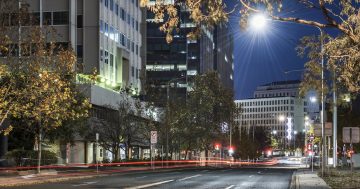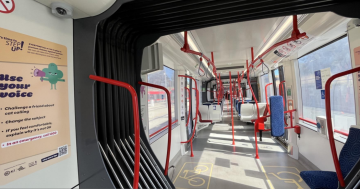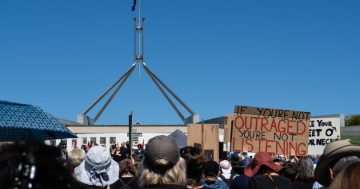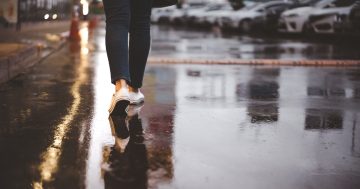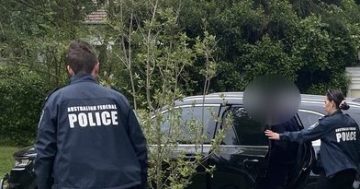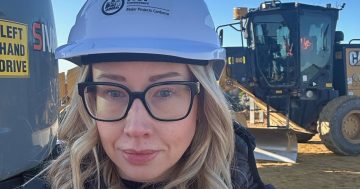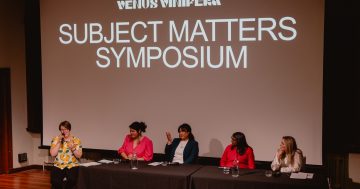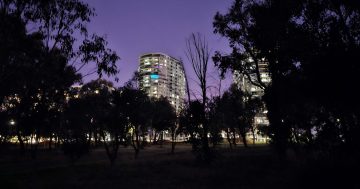
Reclaim the Night walk through Garema Place. Photo: Emma Davidson.
Following the brutal murder of Aiia Maasarwe in Melbourne, it is now, more than ever, important to have a discussion about what makes people feel safe in public spaces.
Everyone has the right to feel safe in our community. And yet, 43 per cent of women in the ACT do not feel safe in Canberra’s public spaces at night, according to the National Survey of Community Satisfaction in 2018. Only 35.7 per cent of ACT women walked alone in the local area after dark and felt safe.
Whether an area has a high crime rate is less of a factor in why women choose not to use public spaces after dark than whether they feel safe. ABS data on personal safety from 2016 shows that one in four Australian women did not walk alone in their local area at night because they felt unsafe, compared to one in 24 men.
Women are more likely to be assaulted in their own home by someone they know, not by a stranger on the street. But women’s fear of sexual assault by a stranger in a public space does result in men and women using public spaces differently and having different concerns about what might be a risk to their safety.
That is why Women’s Centre for Health Matters (with the assistance of a small grant from the ACT Government) developed an online Safety Map to collect information about where people feel safe or unsafe in the ACT, and why they feel that way. The findings from June 2016 to August 2018 have now been collated and published. The tool remains open to reports, and updates to the results are expected in future.
Women’s Centre for Health Matters has been sharing this useful information with ACT Government to help in planning. This includes information about areas where improvements are needed to lighting and visibility, and areas where women have pointed out things that make them feel safer such as active use of the space by a diversity of people.
The majority of reports were in the inner north, but there were reports of feeling unsafe in every district of the ACT, including residential streets in the suburbs. The reasons people felt unsafe were similar, no matter what part of the city they were in.
As expected, most reports of feeling unsafe were in CBD or town centres, rather than in residential suburbs. As expected, Haig Park received more unsafe reports than almost any other single location. But 54 per cent of CBD or town centre reports were about commercial zones that were not parks or bus stations. Examples include laneways or carparks, and even busy streets outside cafes and shops.
Lighting was the biggest cause of feeling unsafe: 43 per cent of reports of feeling unsafe including comments like “it’s very dark, don’t feel safe walking at night”.
While both men and women said that lighting was a big factor in whether they felt safe, only women talked about feeling unsafe in areas that were isolated or deserted. 22 per cent of reports by women included comments such as “This whole area at night is very isolating and scary. Too many dark places, and not enough people around”.
There was also a gendered difference in the second biggest cause of feeling unsafe – threat to personal safety from other people in the area. Of the 58 reports including comments about people in the area, men made only ten reports. None identified the gender of the people in the area that they felt were a risk to their safety.
However, 35 per cent of reports by women identified the risk as being from men. The comments made by women were also more likely to specifically name assault, or sexual assault, as the cause for concern:
“A man hangs around here and tries to block women’s path”
“Dangerous men”
“Have had many bad experiences in this carpark, including a physical attack.”
Men referenced alcohol or drugs, mental health, or homelessness in some comments about risk from other people.
“You can’t walk past here without being harassed by chuggers and bums”
A telling example of gendered difference comes in this comment from a woman aged 35 to 54 years walking in a residential area in the early evening:
“I have only received verbal harassment from passing cars, and no direct threats to my or my family’s safety.”
For some people, verbal harassment would make them feel unsafe. I guess it’s all relative – for this woman, verbal harassment from passing cars is “normal”. The normalisation of street harassment is not OK.
This goes to the heart of why so many women feel so unsafe at night that they won’t walk alone in a city as safe as Canberra. The specific risk that causes women to feel unsafe is about crime against their body, not just angry words or being asked for money.
Fear of assault is more intense than a general feeling of being in an unsafe area, and studies have shown that fear is a stronger driver in restricting a person’s use of public spaces.
Men were more likely to worry about being harassed or robbed for money. Women fear being raped and murdered.












